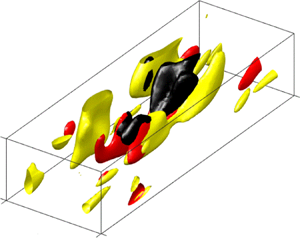Crossref Citations
This article has been cited by the following publications. This list is generated based on data provided by
Crossref.
Wang, Hongping
Yang, Zixuan
Wu, Ting
and
Wang, Shizhao
2021.
Coherent structures associated with interscale energy transfer in turbulent channel flows.
Physical Review Fluids,
Vol. 6,
Issue. 10,
Zhou, Zisong
Xu, Chun-Xiao
and
Jiménez, Javier
2022.
Interaction between near-wall streaks and large-scale motions in turbulent channel flows.
Journal of Fluid Mechanics,
Vol. 940,
Issue. ,
Hernández, Carlos G.
Yang, Qiang
and
Hwang, Yongyun
2022.
Generalised quasilinear approximations of turbulent channel flow. Part 1. Streamwise nonlinear energy transfer.
Journal of Fluid Mechanics,
Vol. 936,
Issue. ,
Kawata, T.
and
Tsukahara, T.
2022.
Spectral analysis on dissimilarity between turbulent momentum and heat transfers in plane Couette turbulence.
Physics of Fluids,
Vol. 34,
Issue. 7,
Hernández, Carlos G.
Yang, Qiang
and
Hwang, Yongyun
2022.
Generalised quasilinear approximations of turbulent channel flow. Part 2. Spanwise triadic scale interactions.
Journal of Fluid Mechanics,
Vol. 944,
Issue. ,
Chua Khoo, Zhao
Chan, Chi Hin
and
Hwang, Yongyun
2022.
A sparse optimal closure for a reduced-order model of wall-bounded turbulence.
Journal of Fluid Mechanics,
Vol. 939,
Issue. ,
Kawata, Takuya
and
Tsukahara, Takahiro
2022.
Spectral Analysis on Transport Budgets of Turbulent Heat Fluxes in Plane Couette Turbulence.
Energies,
Vol. 15,
Issue. 14,
p.
5258.
Yu, Ming
Zhao, MingXiang
Tang, ZhiGong
Yuan, XianXu
and
Xu, ChunXiao
2022.
A spectral inspection for turbulence amplification in oblique shock wave/turbulent boundary layer interaction.
Journal of Fluid Mechanics,
Vol. 951,
Issue. ,
Doohan, Patrick
Bengana, Yacine
Yang, Qiang
Willis, Ashley P.
and
Hwang, Yongyun
2022.
The state space and travelling-wave solutions in two-scale wall-bounded turbulence.
Journal of Fluid Mechanics,
Vol. 947,
Issue. ,
Parente, E.
Farano, M.
Robinet, J.-Ch.
De Palma, P.
and
Cherubini, S.
2022.
Continuing invariant solutions towards the turbulent flow.
Philosophical Transactions of the Royal Society A: Mathematical, Physical and Engineering Sciences,
Vol. 380,
Issue. 2226,
Ciola, N.
De Palma, P.
Robinet, J.-C.
and
Cherubini, S.
2023.
Nonlinear optimal perturbation of turbulent channel flow as a precursor of extreme events.
Journal of Fluid Mechanics,
Vol. 970,
Issue. ,
Cheng, Cheng
and
Fu, Lin
2023.
A scale-based study of the Reynolds number scaling for the near-wall streamwise turbulence intensity in wall turbulence.
International Journal of Heat and Fluid Flow,
Vol. 101,
Issue. ,
p.
109136.
Holford, Jacob J.
Lee, Myoungkyu
and
Hwang, Yongyun
2023.
Optimal white-noise stochastic forcing for linear models of turbulent channel flow.
Journal of Fluid Mechanics,
Vol. 961,
Issue. ,
Symon, Sean
Madhusudanan, Anagha
Illingworth, Simon J.
and
Marusic, Ivan
2023.
Use of eddy viscosity in resolvent analysis of turbulent channel flow.
Physical Review Fluids,
Vol. 8,
Issue. 6,
Zhao, Yunchao
Fan, Yitong
and
Li, Weipeng
2024.
Reynolds number effects on a velocity–vorticity correlation-based skin-friction drag decomposition in incompressible turbulent channel flows.
Journal of Fluid Mechanics,
Vol. 979,
Issue. ,
Cavallazzi, Giorgio Maria
Guastoni, Luca
Vinuesa, Ricardo
and
Pinelli, Alfredo
2024.
Deep Reinforcement Learning for the Management of the Wall Regeneration Cycle in Wall-Bounded Turbulent Flows.
Flow, Turbulence and Combustion,
Yu, Ming
Zhou, ZiSong
Dong, SiWei
Yuan, XianXu
and
Xu, ChunXiao
2024.
On the generation of near-wall dilatational motions in hypersonic turbulent boundary layers.
Journal of Fluid Mechanics,
Vol. 984,
Issue. ,
Ciola, N.
De Palma, P.
Robinet, J.-C.
and
Cherubini, S.
2024.
Large-scale coherent structures in turbulent channel flow: a detuned instability of wall streaks.
Journal of Fluid Mechanics,
Vol. 997,
Issue. ,
SONG, Hanqi
MA, Mingze
ZHANG, Jinrong
LI, Yifan
and
YAN, Chao
2024.
A production term correction for Menter shear-stress transport turbulence model for adverse pressure gradient flows before separation.
Chinese Journal of Aeronautics,
p.
103341.
Yin, Le
Hwang, Yongyun
and
Vassilicos, John Christos
2024.
Dynamics of turbulent energy and dissipation in channel flow.
Journal of Fluid Mechanics,
Vol. 996,
Issue. ,
